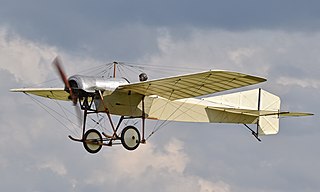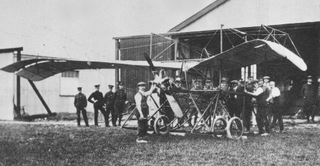Related Research Articles

The Avro Type D was an aircraft built in 1911 by the pioneer British aircraft designer A.V. Roe. Roe had previously built and flown several aircraft at Brooklands, most being tractor layout triplanes. The Type D was his first biplane.

The Morane-Borel monoplane was an early French single-engine, single-seat aircraft. It was flown in several European air races.

The Flanders F.4 was a 1910s British experimental military two-seat monoplane aircraft that was designed and built by Howard Flanders as a development of the Flanders F.3.

The Farman F.500 Monitor was a 1950s Franco-Belgian two-seat training aircraft.

The Farman III, also known as the Henry Farman 1909 biplane, was an early French aircraft designed and built by Henry Farman in 1909. Its design was widely imitated, so much so that aircraft of similar layout were generally referred to as being of the "Farman" type.

The AVIA FL.3 was an Italian two-seat cabin monoplane designed and built by Azionaria Vercellese Industrie Aeronautiche (AVIA) who were later taken over by Lombardi in 1947.

The Blackburn Type D, sometimes known as the Single Seat Monoplane, was built by Robert Blackburn at Leeds in 1912. It is a single-engine mid-wing monoplane. Restored shortly after the Second World War, it remains part of the Shuttleworth Collection and is the oldest British flying aeroplane.

The Handley Page Type G was a two-seat British biplane, designed by Handley Page that first flew in 1913. Only one was built.

The Farman F.1000 was a 1930s French monoplane designed by Farman to break the world altitude record.

The Handley Page Type E was a two-seat, single-engined monoplane intended as a demonstrator. Though only one was built, it flew successfully from 1912 to 1914, carrying several hundred passengers and flying several thousand miles.
The Blackburn Type E was a development of the earlier Blackburn Mercury single-engined monoplanes, but was innovative in its use of steel tubing to construct the fuselage. It was built during 1912 to compete in the Military Aeroplane Trials. A single-seat version flew, but the military two-seater did not.

The Dunne D.7 was one of J. W. Dunne's swept wing tailless aircraft designed to have automatic stability, first flying in 1911. It was a single seat, single engined pusher monoplane developed from the unsuccessful D.6.

The Vickers R.E.P. Type Monoplanes were a series of single-engined monoplane aircraft built by Vickers prior to the outbreak of the First World War. They were developed from a French design for which Vickers had purchased a license, with eight being built.

The Heinkel He 71 was a German single-seat monoplane, a smaller version of the two-seat Heinkel He 64. A low-wing monoplane with a fixed conventional landing gear, the prototype first flew with an open cockpit and a 60 hp (45 kW) Hirth HM 60 engine. It was later modified with an enclosed cabin and a 78 hp (58 kW) Hirth HM 4 engine. With additional fuel tanks to increase range it was used by German aviator Elly Beinhorn on a flight around Africa.
The Perry Beadle T.1 was a single-seat, single engine biplane built and flown in the United Kingdom in 1913. In 1914 it flew with a more powerful engine and other modifications as the Perry Beadle T.2, which was acquired by the Royal Navy Air Service at the outbreak of World War I.

The Blériot 111 was a French four-seat executive transport monoplane designed by André Herbemont. The first French aircraft to be fitted with a retractable landing gear, after six years development it was not ordered into production.
The Scottish Aeroplane Avis was a tractor monoplane built by Howard T. Wright in 1909. At that time Wright was one of England's foremost aircraft engineers, and had several monoplane aircraft under development. The Avis was shown at the 1910 Aero Exhibition in London and several examples were successfully flown during 1910.

The Wibault 360 was a 1930s French five-passenger airliner designed and built by the Wibault company.

The Short S.36 was a British two-seat tractor biplane, built by Short Brothers for Francis McClean in 1911. It was later developed into the Short S.41 and Short S.45, which were the first of a long series of similar aircraft built for the RNAS and RFC.

The Martin Handasyde No.3 was an early British single-seat monoplane design, built in partnership by H.P. Martin and George Handasyde. Only one was built.
References
- ↑ "Aeroplane Accident At Brooklands - Mr. E.V.B Fisher and Passenger Killed". News. The Times. No. 39898. London. 14 May 1912. col F, p. 9.
- The Illustrated Encyclopedia of Aircraft (Part Work 1982-1985), 1985, Orbis Publishing